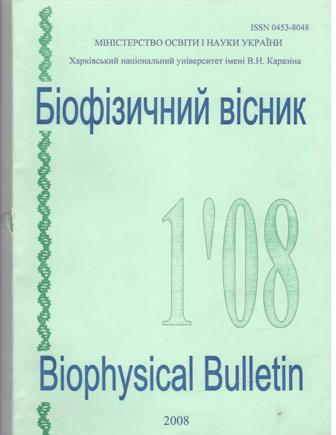Про роль повітроносних пазух в аеродинаміці носової порожнини
Анотація
Побудована спрощена модель носової порожнини з урахуванням наявності в ній повітроносних пазух. Зроблено спробу визначити основні параметри і характеристики аеродинамічного потоку при його поширенні в носовій порожнині. Розглянуто задачу про вплив гайморової порожнини на аеродинаміку носової порожнини в нормальному режимі, коли порожнина сполучається з носовою ходою за допомогою соустя, і патологічному режимі, коли порожнину закупорено і відсічено від носового ходу.
На підставі теореми Гаусса і рівняння безперервності показано, що воздухоносна порожнина є слабо вентильованою зоною. Вентильована частина воздухоносноі порожнини становить лише 5% загального її обсягу, а інша частина є зоною застою.
При нормальному функціонуванні органів носової порожнини в ній переважає турбулентний режим повітряного потоку, а при блокуванні носових порожнин внаслідок патології - ламінарний. Особливістю турбулентності потоку є гідродинамічне перемішування середовища, що рухається, що забезпечує більш інтенсивне в порівнянні з ламінарною течією перенесення імпульсу, тепла і маси.
Показано, що в турбулентному режимі, домінуючому в області локалізації носових раковин, зміна температури уздовж осі носової порожнини становить величину близько 2 0 К /м.
Завантаження
Посилання
лицьового черепа / ЖВНГХ.- 2001.- № 2.- С. 64.-69.
2. Бачинський.І.В., Рижик В.М., Гайналь М.О., Дудій П.Ф. Можливості комп'ютерної томографії при діагностиці захворювань верхньощелепних пазух //. ЖВНГХ - 1999.- №3.-С. 54-56.
3. Безшапочний С.Б., Лобурець В.В. Ендоскопічна ендоназальна функціональна хірургія: достоїнства, недоліки, перспективи //Ринологія.- 2002.- №2.- С. 3-10.
4. Chometon F.,Gillieron P., Laurent J.,Ebbo D.. Korfman P.,Lecomte F., Sorrel-Dejerin N. Analyse Sientifique de l'Aérodinamique des Fosses Nasales.Actes du 106éme Congrès Paris (France) d'Oto-Rhmo-Laryngologie et de Chirurgie de la Face et du Cou 1999.
5. Аврунин О.Г., Белецкий Н.И., Березняков А.И. Некоторые особенности динамики атмосферного аэрозоля в носовой полости // Біофізичний вісник.ХНУ - 2007 - Вип. 19 (2). - С. 105-111.
6. Лойцянский Л.Г. Механика жидкости и газа, М.: «Наука», - 1970, - 904 с.
7. Галин Н.М., Кириллов П.Л. Тепломассообмен. М.: Энергоатомиздат, 1987.- 376 с.
8. Физиология человека / Под ред. Р. Шмидта и Г. Тевса - Пер. с англ. М.: «Мир», 1996 -642 с.
Автори, які публікуються у цьому журналі, погоджуються з наступними умовами:
- Автори залишають за собою право на авторство своєї роботи та передають журналу право першої публікації цієї роботи на умовах ліцензії Creative Commons Attribution License, котра дозволяє іншим особам вільно розповсюджувати опубліковану роботу з обов'язковим посиланням на авторів оригінальної роботи та першу публікацію роботи у цьому журналі.
- Автори мають право укладати самостійні додаткові угоди щодо неексклюзивного розповсюдження роботи у тому вигляді, в якому вона була опублікована цим журналом (наприклад, розміщувати роботу в електронному сховищі установи або публікувати у складі монографії), за умови збереження посилання на першу публікацію роботи у цьому журналі.
- Політика журналу дозволяє і заохочує розміщення авторами в мережі Інтернет (наприклад, у сховищах установ або на особистих веб-сайтах) рукопису роботи, як до подання цього рукопису до редакції, так і під час його редакційного опрацювання, оскільки це сприяє виникненню продуктивної наукової дискусії та позитивно позначається на оперативності та динаміці цитування опублікованої роботи (див. The Effect of Open Access).




